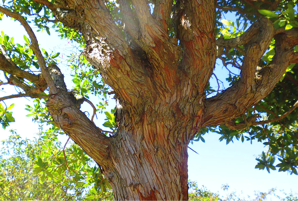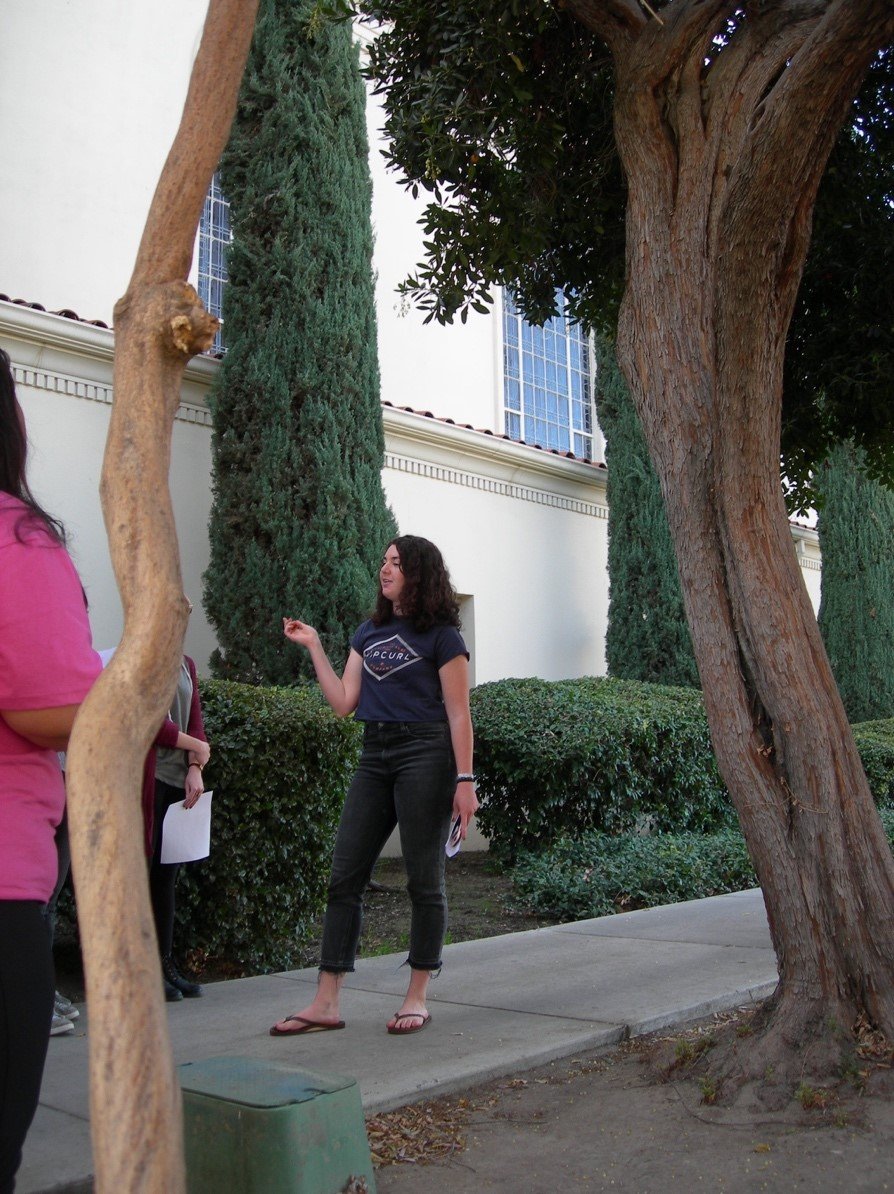University of Redlands Emergency Alert System
Alert Received: . For more information, visit: https://www.redlands.edu/alert/
University of Redlands
- Home
- Trees
- Species Accounts
- Strawberry Tree
Common Name: Strawberry Tree
Scientific Name: Arbutus unedo
Family: Ericaceae
Identification
Habit: The strawberry tree grows into a small tree or large shrub that can range from taller and narrower to shorter with a wide crown. It typically grows in the 8-18 ft (2.5-5.5 m) tall range (though it can reach up to 50 ft or 15 m tall) and 8-20 ft (2.5-6 m) wide. Its trunk grows to about 30 in (75 cm) in diameter. It can have one to many trunks from the same plant. Typically, it grows upward first, creating a dome-like shape, with a bare trunk and full branches with dense crown on top. It should be noted that the growth rate is very slow.
Leaves: The leaves are longer than wide with a slightly rounded tip and toothed edges. They look slightly waxy on top, giving each leaf a sort of glow. Leaves are bright green and have classic looking veins (single midvein running parallel to edges and several veins splitting off that perpendicular to leaf edge).
Twigs and Bark: Twigs are greenish or reddish and medium in width. Bark is typically reddish in color and starts out smooth, though as the tree matures can grow to be thicker, and less red in tone. Branches become twisted and thicker as they grow to support more weight. The tree tends to droop, so pruning may be necessary to encourage healthy growth. Flowers and Fruits: The tree’s blossoms are white, light green at the tips, and bell shaped. When ripe, the fruits are red on the outside with rough/bumpy skin, though as they ripen, they look orange-y and even a light yellow. They are plump and round. On the inside, they are yellow and fleshy, with five seeds at the center and have a “soft jelly-like consistency. The Strawberry fruit replicates flavors reminiscent of apricots and guavas with subtle woody undertones…” The strawberry tree is unusual because it has flowers and fruit at the same time.
Flowers and Fruits: The tree’s blossoms are white, light green at the tips, and bell shaped. When ripe, the fruits are red on the outside with rough/bumpy skin, though as they ripen, they look orange-y and even a light yellow. They are plump and round. On the inside, they are yellow and fleshy, with five seeds at the center and have a “soft jelly-like consistency. The Strawberry fruit replicates flavors reminiscent of apricots and guavas with subtle woody undertones…” The strawberry tree is unusual because it has flowers and fruit at the same time.
http://www.specialtyproduce.com/produce/Strawberry_Tree_10303.php (quote)
Where it’s from
Native range: Most commonly found in climates with minimal seasonal change, the strawberry tree likes warm coastal areas, with some humidity and little rain. The strawberry tree is mostly found in the Mediterranean and Macronesian areas, though it has been planted throughout Europe and the United States as well. “This species can be found from sea level to 800–1200 m and grows in different types of soils though, like many Ericaceae species, it has a certain preference for acid soils.”
https://academic.oup.com/forestry/article/84/4/419/664836
Ecological notes: “…will not flourish if exposed to harsh winds. Young plants can suffer damage in very cold weather”. Otherwise they are hardy and will grow in many types of weather and conditions and soils: “…they will grow in sandy, loamy and even clay soils, as long as there is no waterlogging,” and will even “grow in chalk”.
http://www.telegraph.co.uk/gardening/3324255/How-to-grow-the-strawberry-tree.html. The fruits are a valuable winter food source for woodland animals, especially birds.
What we use it for
It is one of the largest wild fruit producers in the world, most popular in Spain, where it’s used to make wine and jams, or to just eat raw. Some research suggests that compounds in the antioxidant-packed fruits can be used to help with “chronic health disorders, such as cancer and neurodegenerative and cardiovascular diseases, supports the promotion of their consumption as a healthy food.”
Though they are very healthful, they are said to be bitter in taste which may discourage eating, the fruit spoils quickly, and their production rate is very different from year to year, making it difficult to commercialize.
The tree is also widely grown as an ornamental plant.
References:
Biographer:
Claire Jamison ‘21, FYS 20: Plants in Our World, Fall 2017